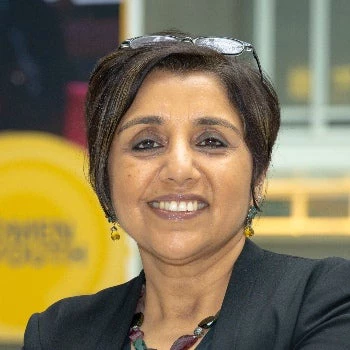So, how can today's youth equip themselves for careers in the age of AI? This question took center stage at the Solutions for Youth Employment (S4YE) Innovation Exchange and Partner Summit on November 7 and 8, drawing more than 1,000 attendees from 125 countries.
World Bank Vice President of Human Development Mamta Murthi anchored the discussion by referencing two pertinent recent events: the UK’s AI Safety Summit and the release of the new Beatles song. She stressed that companies and governments are reviewing the need for AI regulations and while guardrails were important, we shouldn’t lose the thrill that new technology brings and the potential to find new solutions for old problems. In the spirit of embracing excitement, here are five key takeaways from the S4YE Summit:
- Youth are not passive recipients of development aid, they are active agents of change. Throughout the two-day event, many sessions showcased the tangible impact of youth-led tech innovations—from low-cost 3D-printed prosthetic limbs made from recycled materials in Mozambique (BioMec), to an AI-assisted app helping young Syrian refugees in Lebanon identify and address gaps in their education (EduPass). The message was loud and clear: As a development organization, we would be doing ourselves a disservice if we weren’t working hand in hand with youth and empowering them as changemakers.
- To unleash the potential of youth—we need public and private partners to join forces. For example, the governments of India and Egypt are already taking significant steps to prepare their young people for an AI-driven future, leveraging private sector collaborations to create a mutually beneficial environment for innovation and nation-building. Shreshtha Gupta from India’s National Skill Development Corporation (NSDC), a public-private partnership, explained that Skill India uses AI to provide career recommendations and upskilling opportunities, promoting prosperity for one of the youngest nations in the world. Hossam Osman, advisor to Egypt’s Minister of Communications and Information Technology for Technology Innovation, highlighted his government’s ongoing collaboration with private sector players to establish AI innovation hubs offering integrated services for small- and medium-sized enterprises and startups.
- AI can be biased, but we have the chance to tackle existing inequalities if we are intentional with its use. Malik Afegbua, a Nigerian AI artist, filmmaker, and designer, has used AI to create viral fashion designs modeled by elderly people—bringing new and old together in a beautiful way. He countered biases in stock imagery and AI datasets by feeding the tools the type of content he wanted to see, training the technology to bring his vision to life in a way that celebrates ageing, rather than reinforcing ageism in the fashion industry. Harambee's SA Youth platform, which recommends learning and earning opportunities for youth in South Africa, is another impressive example of using AI to combat prejudice. The job candidate matching algorithm has an adjusted weight distribution to help rectify the gender bias in job hunting.
- From beneficiary to innovator—some of the best innovations stem from personal challenges. For instance, Azza ElHayek described her difficult job-hunting experience as a Palestinian refugee arriving in Belgium. Having previously worked as a Data Analyst at the UN Food and Agriculture Organization, she was surprised when the Belgian career guidance services suggested farming as her next professional endeavor. Realizing there was a mismatch between people’s skills and their job opportunities, and a general lack of information about the labor market, she decided to take matters into her own hands by creating SkillLab—a mobile app for connecting job seekers, skills-based educators, and employers.
- AI and humans can co-create value. Throughout the summit, several speakers acknowledged the risks of job loss from AI and technology, but ultimately emphasized that such tools can be our assistants, rather than replacements. In many cases, AI can free up cognitive space and time for us to focus on the more human elements of work, like empathy and imagination. Plus, getting the best results from AI requires human curation and refinement skills at every stage. We can think of generative AI tools as interns who help us with our tasks, rather than competitors who take away our roles. Naria Santa Lucia, general manager of Microsoft Philanthropies, hit the nail on the head during her remarks, quoting economist Richard Baldwin: “AI won’t take your job, but somebody using AI will take your job.”
From fear to FOMO
As we navigate the uncharted territories of AI, it’s interesting to draw parallels to historical examples of inventions being met with skepticism. Past fears of steam trains causing health issues or photography destroying fine art proved unfounded, for instance. While risk analysis and regulation are certainly necessary, so is optimism and willingness to adapt. It’s clear that the young generation are digital natives and energetic innovators and, with the right support from the public and private sector, they have a unique opportunity to embrace new technologies.
As I reflect on all the rapid-fire presentations made during the S4YE Partner Summit last week, listening to the innovative programs being led by our partners and the creative solutions being designed by young people themselves all over the globe, I can’t help but think about the potential that we could unleash if we combined these innovative ideas with the scale and influence of the World Bank. Addressing youth employment is one of our key development goals, but perhaps we are only scratching the surface of the transformative potential of partnerships.
To receive weekly articles, sign-up here



Join the Conversation